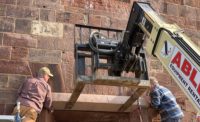Europe has a continuous, documented history of building with lime dating from the Roman Republic. The above referenced standard is the U.K. implementation of the European Committee for Standardization Cement and Building Lime Technical Committee 51. The European Committee for Standardization is an international non-profit providing a similar function to the American Society for Testing and Materials in the United States and Canada. The standard is a comprehensive document for defining and distinguishing manufactured limes used in construction. Parts two and three of the standard refer to Testing Methods and Conformity Evaluation, respectively.
Whereas lime enjoyed only a brief history of widespread use being largely displaced by Portland cement in North America, in Europe and the United Kingdom, the tradition is maintained and is inclusive of a wide range of limes. This post is a follow up on a previous article on natural hydraulic limes. Hopefully, it will serve to dispel some of the mystery and confusion surrounding the classification of NHL’s and highlight the balanced rationale based on experience, science, and practical use reflected in the European standard.
Louis Vicat
In our previous article, we briefly discussed the long history of hydraulic limes from Roman times, through the Renaissance, and culminating in a scientific understanding in the early 19th century. Frenchman Louis Vicat began his career as an engineer, conducting research into limes used for hydraulic works. Although, hydraulic lime works had already been underway since the mid-18th century. Vicat was the first to consolidate the research and publish a comprehensive paper in 1818. Ten years later he would revise and expand upon his original work, publishing Résumé des Connaissances Positives Actuelles sur les Qualités, le Choix et la Convenance Reciproque des Matériaux Propres et la Fabrication des Mortiers et Ciments Calcaires, mercifully abbreviated to Mortars and Cements in Captain John Thomas Smith’s 1837 English translation.
Vicat’s testing procedures and classification index was to be the standard until recent times, and the principles on which they were based still are. His determination for classification was primarily twofold. The first was the chemical composition and percentage of argillaceous (clayey) infiltration in the given limestone under test. Second, was the reactivity and hydraulicity of the quicklime produced from said limestone. Below is a summary of typical characteristics with approximate ranges for which Vicat himself acknowledged and documented exceptions:
Rich Limes
- Containing less than 6 percent of inert impurities
- Very reactive with a swelling during slaking exceeding 2 times in volume
- No set with water
Lean or Poor Limes
- Containing less than 30 percent of inert impurities
- Significantly less reactive with minimal swelling during slaking
- No set with water
Feebly Hydraulic Limes
- Containing less than 12 percent of active* impurities
- Reactive with minimal swelling during slaking
- Set in 15 to 20 days
Moderately Hydraulic Limes
- Containing less than 18 percent of active* impurities
- Significantly less reactive with minimal swelling during slaking
- Set in 6 to 8 days
Eminently Hydraulic Limes
- Containing less than 25 percent of active* impurities
- Almost unreactive with little to no swelling during slaking
- Set in 2 to 4 days
*Vicat does explain that by active he refers to silica not alumina
Vicat’s developed a precise method so that he could consistently define when his tested limes achieved a set. However, he also furnishes his readers with a useful explanation that a “set” approximately corresponded to the hardness reached when the mean or average pressure exerted by the arm would resist an impression by the fingertip. I appreciated reading his book as he always provides both scientific, laboratory methods and results, as well as practical tests that would be useful in the field for prospectors or workmen.
EN 459-1:2010
Despite our focus in this post on NHL’s, I will say the EU standard provides useful information for a broader range of building limes. For example, there are concise definitions for quicklime and hydrated limes, high calcium and dolmitic limes with impurity percentile categorizations roughly corresponding to Vicat’s rich, lean and poor classifications. Also, there are additional classifications for “Formulated” and “Hydraulic” limes that have additions of pozzolans, fillers, cements, fly ash, etc.
Natural Hydraulic Limes fall under three classifications: NHL 2, NHL 3.5 and NHL 5. Not unlike Vicat, the classification is based primarily on two factors: chemistry and set. However, the calculations are arrived at somewhat differently.
NHL 2
- Available hydrated lime, Ca(OH)2 ≥ 35 percent
- Compressive strength at 28 days, ≥ 2 to ≤ 7 MPa*
*A megaPascal (MPa) or Newton (N/mm2) is a metric unit of pressure roughly corresponding to 145 psi
NHL 3.5
- Available hydrated lime, Ca(OH)2 ≥ 25 percent
- Compressive strength at 28 days, ≥ 3,5 to ≤ 10 MPa
NHL 5
- Available hydrated lime, Ca(OH)2 ≥ 15 percent
How do these NHL classifications compare with Vicat’s? The chemical requirements are a bit different. Vicat’s tests were based on setting underwater, whereas the NHL testing is determined by compressive strength. As a result, they don’t compare exactly.
Nevertheless, at least in regard to compressive strength, an average NHL 2 generally corresponds and tests within range of what Vicat had classified as moderately hydraulic lime. NHL 3.5 overlaps between the stronger moderately and weaker eminently hydraulic lime. An average NHL 5 corresponds to the stronger eminently hydraulic lime and stronger NHL 5’s exhibit compressive strengths corresponding to what Vicat might have classified as a Natural cement. Although, there are other requirements under the NHL designation such as water demand and retention, bulk density, whiteness etc. This provides an overview of how the two classifications bear some relationship to one another.
Practical Implications
Why the broad range of allowable compressive strengths for each NHL classification? I’ve yet to read any published documentation addressing this question; however, there appears to be a general consensus among those involved in manufacturing. Testing requirements for manufacturers as prescribed by EN 459-2:2010 are designed to achieve optimal compressive strengths under laboratory conditions. The mortar has a proportion of one part freshly baked NHL to three parts of specified sand by weight (approx. 1:1 by volume). Only enough water is added to the mix to vibrate and compress.
Typical field use NHL to sand ratios from 1:1.5 to 1:3 by volume, additional water for workability, lack of vibration/compression are just some of the factors that make it highly unlikely anything near a manufacturer’s published compressive strengths will be achieved in the field at 28 days. The various designated manufacturing requirements of NHL 2, 3.5 and 5 refer to minimum compressive strength requirements in MPa under lab conditions to ensure that mortars reach a practical compressive strength in the field. For sensitive restoration work, it is best practice to perform tests on actual mortars under consideration for use in the field rather than rely exclusively on a published manufacturer’s compressive strength.
Average compressive strengths of the classification are as follows:
- NHL 2 – 4.5 MPa
- NHL 3.5 – 6.75 MPa
- NHL 5 – 10 MPa
A significant requirement of the NHL classification is that almost no additions are allowed. The single exception is 0.1 percent of a grinding agent helpful in the manufacturing process. Two important components result from the baking and subsequent slaking of limestone utilized for NHL: hydrated lime, Ca(OH)2 and belite, a dicalcium silicate that forms in the baking process. The belite is the component responsible for the hydraulicity of the NHL. During the baking some of the belite agglomerates form small pebbles. Manufacturers often retain these in the screening process. Manufacturers are permitted to grind these and add them back into the NHL to increase the hydraulicity. This is not considered an addition as it is a component of the original limestone. This is how some manufacturers are able to produce multiple NHL designations from a single limestone source.
There is some controversy over whether it is acceptable practice for an engineer or craftsman to add hydrated or putty lime to lower the compressive strength of NHL mortars in the field. As shown above hydrated lime is already a main component of NHL so there is no fundamental incompatibility. Extensive testing of the effect of high calcium hydrated lime mortars in NHL mortars have been conducted in the U.K. and results published in Hydraulic Lime Mortar for Stone, Brick and Block Masonry. Estimates for reduction in compressive strength from the addition of lime putty are more difficult to predict as factors such as, length of slaking, and water content can vary results considerably.
Historically, pozzolans such as microsilicas, have been added for the occasional need to increase compressive strength, accelerate the set or otherwise alter the properties of NHL mortars. It would be advisable to consult with an expert in the potential long term effects of any such additions.








Report Abusive Comment